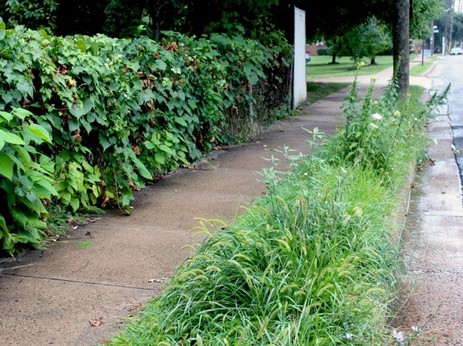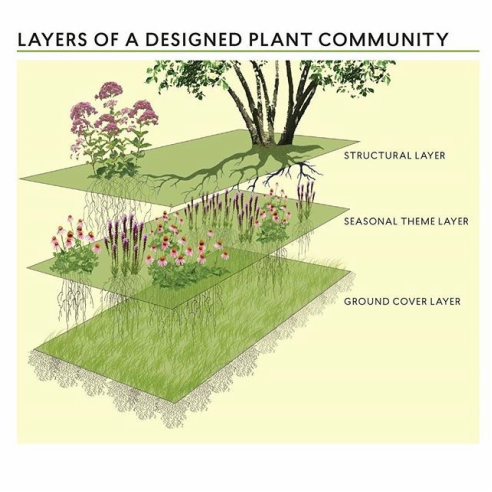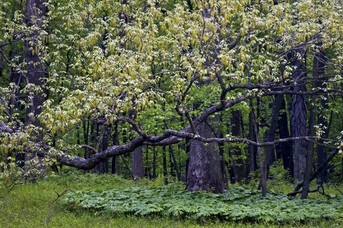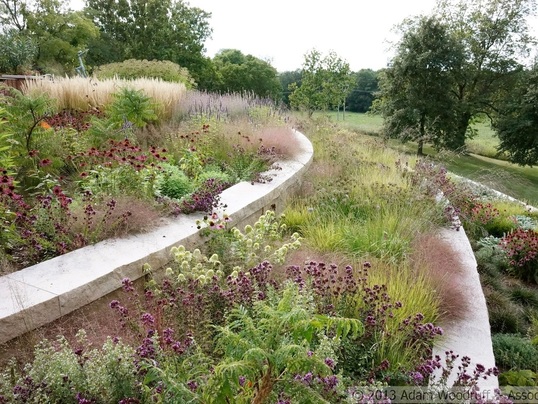|
by Dawn Szelc of Clear Blue Landscapes The February meeting of the Landscapes Designer’s Group was held in Washington, D.C. at the Metropolitan United Methodist Church. Our speaker, Thomas Rainer, is a registered landscape architect from Rhodeside & Harwell. Thomas has a new book available called “Planting in a Post-Wild World” with co-author designer Claudia West. He provided us with a very thought provoking presentation on a new view of planting design. Thomas began speaking about his childhood growing up in Birmingham, AL and roaming through the woods in wild places. He also discussed his career track through Oehme van Sweden and now at Rhodeside & Harwell. He has realized that the way we design our gardens is quite different from the way nature creates plant communities. Wild places have many stresses yet plants still thrive. An example is the hell strip that Thomas found in his Arlington neighborhood, pictured below, where all variety of plants have established themselves. Mulch is not found in the wild, instead all types of plants cover the soil, especially low growing plants. Also in the wild the plant color palette is very harmonious, while we try to sometimes use very drastic colors against each other. Natural plant communities are complex adaptive systems and have very deep roots that allow them to survive some harsh conditions. He is recommending to design our own plant communities using these same principals. The first concept is to relate the plants to the place, using plants from similar biomes. Some examples would be an open sunny place design would be modeled after grassland, a part shade spot would be similar to a woodland or scrubland, and a closed canopy designed like a forest. A lawn should be considered as an area rug, so a small part of the overall design. Thomas gave some sources of plant mix ideas – one was Noel Kingsbury’s blog and specifically “It’s All In the Mix” http://noels-garden.blogspot.com/2013/09/its-all-in-mix-resources-for.html . He also mentioned Bernd Hertle who is a German designer and showed his Midsummer Night’s Dream plant mix in a traffic median in Germany. Many of these ideas have been used extensively in Germany and were familiar to Claudia as she grew up on a family nursery in eastern Germany. The next concept is to relate the plants to other plants with vertical layering. Thomas discussed three layers – Structural layer, Seasonal theme layer, and ground cover layer. The ground cover layer includes the plants that would cover the soil so that mulch is not required. He showed woody plants under-planted with low growers. Some examples were Geum fragaroides, Meehania cordata, and Juncus tenuis. He also provided a few examples for dry shade such as Erigeron pulchelles var pulchelles “Lynnhaven’s carpet”.
There were numerous questions from the audience about this very different way to view planting design. Someone asked about whether the plants needed to be divided. Thomas thought that was not necessary but that you may need to add diversity as some plants die off. For the colonial houses common in our area, he believes this design method will work but that you may need to add more structure. Adding evergreens and structural elements is very important. Thomas also suggested using staggered age plants – some gallons and some plugs to keep the area filled in. Our appreciation goes out to Thomas for providing us with his view of this new idea of planting design and showing some beautiful examples of how it can be incorporated into many different sites.
0 Comments
|
AuthorsLDG is a non-profit corporation dedicated to the exchange and enhancement of knowledge relevant to the landscape design profession. We are a group of professional designers in the metropolitan Washington, DC area. Membership is meant for students studying and professionals employed in landscape design or associated professions (i.e. arborists, installers, contractors, etc.). Archives
October 2023
CategoriesPast Newsletters can be found in the Members Only Section of the LDG Membership Connection. You must sign in to view these files.
Past Newsletters |
|
Search for a Landscape Designer in Your Area:
|




 RSS Feed
RSS Feed
